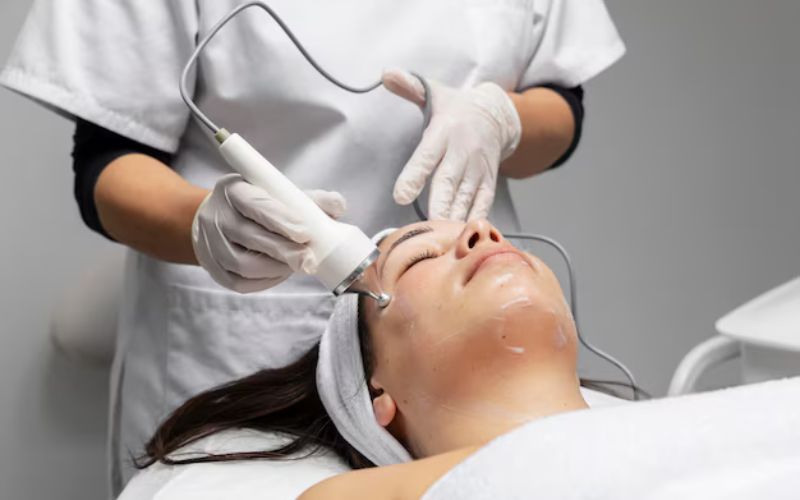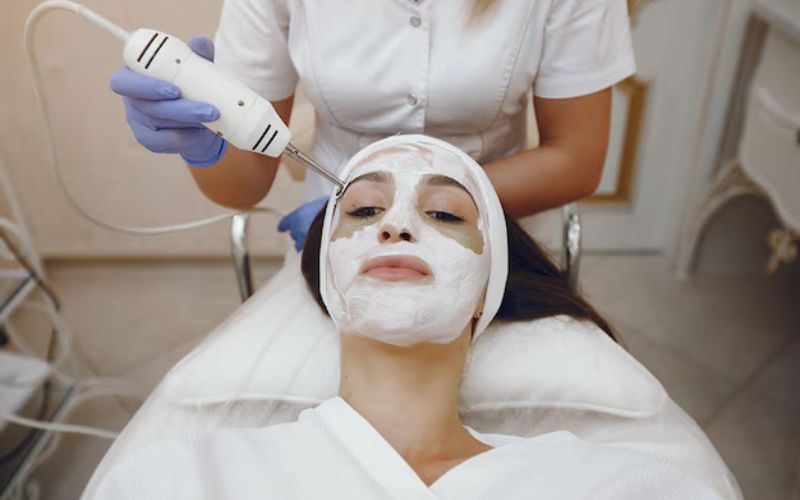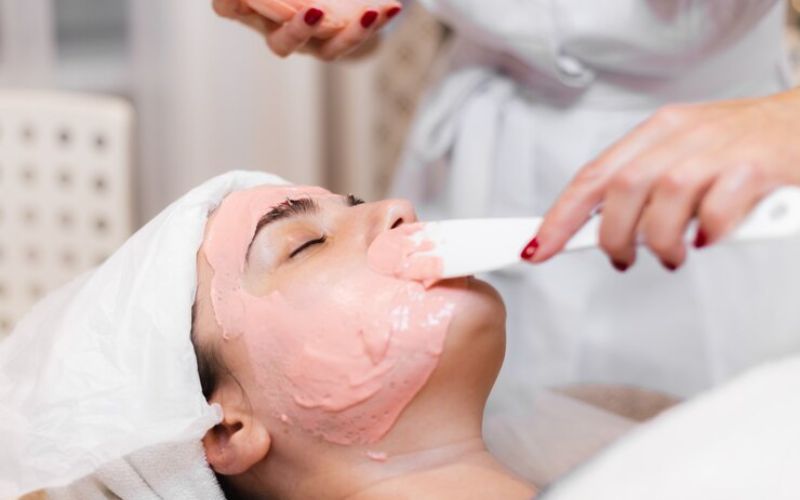Introduction
Chemical peels are a popular cosmetic treatment designed to improve the appearance and health of the skin. Whether you're dealing with hyperpigmentation, fine lines, or acne scars, chemical peels can provide significant skin rejuvenation. In this comprehensive guide, we'll explore the different types of chemical peels, their benefits, and which options might be best suited for your skin type and concerns. At KJ Aesthetics, under the expert care of Dr. Vishal Brahmabhatt, we aim to provide the best chemical peel treatments tailored to your individual needs.
What Are Chemical Peels?
Chemical peels involve applying a chemical solution to the skin, causing it to exfoliate and eventually peel off. The new, regenerated skin is usually smoother and less wrinkled than the old skin. Chemical peels can be used on the face, neck, and hands and are effective in treating a variety of skin issues.
Key Benefits of Chemical Peels

Types of Chemical Peels
Chemical peels are categorized into three main types based on their depth of penetration into the skin: superficial peels, medium peels, and deep peels.
1. Superficial Peels Superficial peels are the mildest form of chemical peel and are often referred to as "lunchtime peels" because they require minimal downtime. These peels typically use alpha-hydroxy acids (AHAs) or beta-hydroxy acids (BHAs) to gently exfoliate the outermost layer of the skin.
Best for:
Glycolic Acid: An AHA that helps with exfoliation and skin brightening. Salicylic Acid: A BHA particularly effective for acne-prone skin.
Procedure: The procedure is quick, usually lasting around 30 minutes. After cleansing the skin, the chemical solution is applied and left on for a few minutes before being neutralized and removed.
Recovery: There is little to no downtime, and patients can usually return to their normal activities immediately. Mild redness might occur, but it typically resolves within a few hours.
2. Medium Peels
Medium peels penetrate deeper into the skin, reaching the middle layers of the dermis. These peels are often used to treat more severe skin issues, such as hyperpigmentation, deeper wrinkles, and moderate acne scars.
Best for: Moderate wrinkles and fine lines Hyperpigmentation, including melasma Age spots and freckles
Common Ingredients:
Trichloroacetic Acid (TCA): A common agent in medium peels that helps in treating more significant skin imperfections.
Jessner's Solution: A combination of lactic acid, salicylic acid, and resorcinol, often used for treating hyperpigmentation.
Procedure: The procedure for a medium peel takes longer, around 30 to 60 minutes. After cleansing, the chemical solution is applied to the skin, and patients might feel a burning or stinging sensation. The solution is then neutralized after the desired depth of penetration is achieved.
Recovery: Medium peels require a longer recovery time, with redness, swelling, and peeling lasting for about one to two weeks. During this period, it's crucial to avoid sun exposure and follow aftercare instructions provided by your dermatologist.
3. Deep Peels
Deep peels are the most intensive type of chemical peel, penetrating deep into the skin to address severe skin issues. Due to their potency, these peels are typically only performed once and require significant downtime.
Best for: Severe wrinkles and fine lines Deep scars, including acne scars Pre-cancerous growths
Common Ingredients: Phenol: The strongest chemical used in deep peels, effective for dramatic skin resurfacing.
Procedure: Deep peels are a more complex procedure, often requiring sedation. The chemical solution is applied to the skin and left on for a longer period, allowing it to penetrate deeply. The procedure can last up to two hours.
Recovery: Recovery from a deep peel is extensive, often requiring up to two months. Patients will experience significant redness, swelling, and peeling, and it's essential to avoid any sun exposure during this time. Strict aftercare is necessary to ensure proper healing and optimal results.
Is Chemical Peeling Good for Skin?
Yes, chemical peels can be highly beneficial for the skin when performed correctly and tailored to the individual's skin type and concerns. Chemical peels help to remove dead skin cells, promote cell turnover, and stimulate collagen production, resulting in smoother, brighter, and more even-toned skin. They are effective for treating a variety of skin issues, including:
Hyperpigmentation: Chemical peels can reduce dark spots and even out skin tone.
Acne and Acne Scars: Peels can help unclog pores, reduce acne breakouts, and diminish the appearance of acne scars.
Fine Lines and Wrinkles: By promoting collagen production, chemical peels can reduce the appearance of fine lines and wrinkles.
Rough Skin Texture: Peels smooth the skin's surface, improving texture and overall skin quality.
However, the effectiveness and safety of a chemical peel depend on selecting the right type of peel for your skin, proper application, and post-care. Consulting with a qualified professional, such as Dr. Vishal Brahmabhatt at KJ Aesthetics, is essential to achieving the best results while minimizing risks.
Is Chemical Peel Painful?
The sensation experienced during a chemical peel can vary depending on the depth of the peel:
Superficial Peels: These peels are usually well-tolerated, with patients often experiencing a mild tingling or stinging sensation that subsides quickly.
Medium Peels: These can cause a more intense burning or stinging sensation during the procedure, which may be uncomfortable but is usually manageable. The discomfort typically lasts only a few minutes, and your dermatologist may use a fan or cool compresses to alleviate the sensation.
Deep Peels: These are the most intense and can be quite painful. For deep peels, sedation or local anesthesia is often used to minimize discomfort. The recovery period can also involve pain or discomfort as the skin heals.
Overall, while some discomfort is expected, it is generally temporary and can be managed with proper care and support from your healthcare provider.
How Long Will a Chemical Peel Last?
The longevity of the results from a chemical peel depends on several factors, including the type of peel performed, your skin type, and how well you care for your skin post-treatment.
Superficial Peels: Results from superficial peels are subtle and short-lived, typically lasting a few weeks. These peels are often done in a series to achieve more significant results over time.
Medium Peels: The results of a medium peel are more noticeable and can last several months, depending on your skin type and how you care for your skin afterward. It’s recommended to have these peels less frequently, about once every few months.
Deep Peels: Deep peels provide the most dramatic and long-lasting results, often lasting several years. However, because they are so intense, they are usually performed only once.
To maintain the results of a chemical peel, it's crucial to follow a good skincare routine, protect your skin from the sun, and consider periodic maintenance treatments as advised by your dermatologist.
If you're considering a chemical peel and want to learn more about how it can benefit your skin, how it feels, and what to expect in terms of results, KJ Aesthetics and Dr. Vishal Brahmabhatt are here to guide you through the process with expert advice and care tailored to your unique skin needs.

Best Chemical Peel for Hyperpigmentation
Hyperpigmentation is a common skin concern characterized by darkened areas on the skin due to excess melanin production. It can be caused by various factors, including sun exposure, inflammation, hormonal changes, and aging.
At KJ Aesthetics, we understand that finding the best chemical peel for hyperpigmentation requires an individualized approach. Here are some of the most effective chemical peels for treating hyperpigmentation:
Glycolic Acid Peels
Glycolic acid is an AHA derived from sugar cane. It's highly effective in exfoliating the skin and promoting cell turnover, making it ideal for treating hyperpigmentation. Glycolic acid peels are typically offered as superficial peels, making them suitable for patients with mild to moderate hyperpigmentation.
TCA Peels
Trichloroacetic acid (TCA) is used in medium to deep peels and is one of the most effective treatments for more severe cases of hyperpigmentation. It works by penetrating the deeper layers of the skin, promoting the removal of damaged skin cells and encouraging the regeneration of new, evenly pigmented skin.
Jessner's Peels
Jessner's solution is a combination of lactic acid, salicylic acid, and resorcinol, and is particularly effective for treating melasma and other forms of hyperpigmentation. It works by breaking down the pigmented cells and promoting an even skin tone.
Kojic Acid Peels
Kojic acid is a natural ingredient derived from fungi that inhibits the production of melanin, making it an excellent option for treating hyperpigmentation. It is often combined with other ingredients in chemical peels to enhance its effectiveness.
Choosing the Right Chemical Peel
Selecting the best chemical peel for your skin depends on several factors, including your skin type, the severity of your skin concerns, and your overall skin health. At KJ Aesthetics, Dr. Vishal Brahmabhatt conducts a thorough skin analysis to determine the most suitable peel for your needs.
Factors to Consider
Skin Type: Different peels are suitable for different skin types. For instance, AHAs like glycolic acid are generally safe for most skin types, while BHAs like salicylic acid are better suited for oily and acne-prone skin.
Skin Concerns: The severity of your skin issues will dictate the depth of the peel needed. Superficial peels are great for mild concerns, while medium and deep peels are necessary for more significant issues.
Downtime: Consider how much downtime you can accommodate. Superficial peels have minimal downtime, while deep peels require an extended recovery period.
The Procedure: What to Expect
If you're considering a chemical peel at KJ Aesthetics, it's essential to know what to expect during the procedure and recovery.
Consultation: Before undergoing a chemical peel, you'll have a consultation with Dr. Vishal Brahmabhatt to discuss your skin concerns, medical history, and treatment goals. A skin analysis will be performed to determine the most suitable peel for you.
During the Procedure: The skin will be cleansed thoroughly to remove any oils or impurities. The chemical solution will then be applied to your skin using a brush, cotton ball, or gauze. Depending on the type of peel, the solution will be left on your skin for a few minutes before being neutralized.
Post-Procedure Care: After the peel, your skin will be sensitive, and you'll need to follow specific aftercare instructions. This typically includes: Avoiding sun exposure and using a high-SPF sunscreen Keeping the skin moisturized Avoiding picking or peeling the skin Using gentle, non-irritating skincare products
The Science Behind Chemical Peels
Chemical peels work by utilizing acids to break down the bonds between dead skin cells, allowing them to be sloughed off and revealing fresh, new skin underneath. The depth of the peel determines how much of the skin is removed and how intense the results will be.
Cell Turnover and Regeneration: As we age, our cell turnover rate decreases, leading to a build-up of dead skin cells on the surface. Chemical peels accelerate cell turnover, promoting the shedding of old skin and the growth of new, healthy cells.
Collagen Production:
Deeper chemical peels stimulate collagen production, which is crucial for maintaining skin elasticity and reducing the appearance of wrinkles and scars.
Potential Risks and Side Effects
While chemical peels are generally safe when performed by a qualified professional, they do come with potential risks and side effects. It's important to be aware of these before undergoing treatment.
Common Side Effects: Redness and swelling Peeling and flaking of the skin Temporary darkening of the skin (post-inflammatory hyperpigmentation) Sensitivity to sunlight
Serious Risks: Scarring (rare, but more likely with deep peels) Infection Prolonged redness or irritation Allergic reactions to the chemical solution To minimize the risks, it's crucial to follow all pre- and post-treatment instructions provided by Dr. Vishal Brahmabhatt.
Why Choose KJ Aesthetics for Your Chemical Peel?
At KJ Aesthetics, we are committed to providing the highest standard of care to our patients. Dr. Vishal Brahmabhatt brings years of experience and expertise in dermatology, ensuring that you receive safe and effective treatment tailored to your unique skin needs.
Personalized Care: We understand that every patient's skin is different. That's why we offer personalized treatment plans designed to address your specific concerns and goals.
State-of-the-Art Facility: Our clinic is equipped with the latest technology and adheres to the highest safety standards, ensuring that you receive the best possible care.
Expertise in Hyperpigmentation:
Hyperpigmentation can be challenging to treat, but with the right approach, significant improvements can be achieved. At KJ Aesthetics, we specialize in treating hyperpigmentation with customized chemical peel treatments.
Frequently Asked Questions (FAQ)
A chemical peel is a cosmetic treatment that involves applying a chemical solution to the skin to exfoliate and remove the outer layers. This process reveals fresher, smoother skin underneath and can help address a variety of skin concerns, including hyperpigmentation, acne, fine lines, and wrinkles.
Yes, chemical peels are generally safe when performed by a qualified professional. However, it's essential to choose the right type of peel for your skin type and concerns. Consulting with a dermatologist, like Dr. Vishal Brahmabhatt at KJ Aesthetics, ensures that the procedure is tailored to your needs and minimizes risks.
Conclusion
Chemical peels offer a powerful solution for various skin concerns, from hyperpigmentation and acne scars to fine lines and wrinkles. Understanding the different types of chemical peels and choosing the right one for your skin can make a significant difference in your results. At KJ Aesthetics, Dr. Vishal Brahmabhatt and his team are dedicated to helping you achieve your best skin with safe, effective, and personalized chemical peel treatments.

